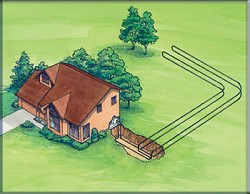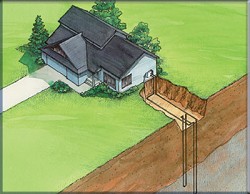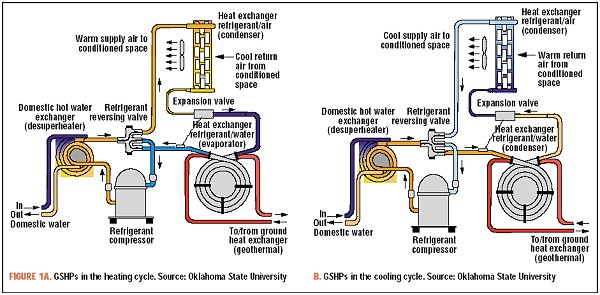Geothermal heating and cooling
What is it ?
The earth is used as a constant temperature source/sink for a Geothermal Exchange HVAC system. An extensive ground water loop (three 400 foot wells) are used to feed a Ground Source Heat Pump. The heat pump is used to heat or cool ducted air and as a by product of it's use the system generates hot water for Domestic use (showers etc) and to heat the radiant slab in the basement.
Why do it ?
I could come up with lots of reasons but the biggest is cutting energy costs ($'s). Some of the other reasons are to be a green project, we are burning no one-site fuels to heat and cool the house all our heat for the winter comes from the constant tempature of the earth below us (somewhere in the 55 degree range), cost wise the system added an extra $25,000 to the cost of the house (just a bit less than the cost of connecting to the gas lines). Expected cost of operation should be in the $200 a month rather than the Gas/Electric option of $500+. The obvious thought is that it might take 8 years to recover the investment but in reality the savings is a 16% return on investment if the price of Gas and Electric don't rise. And the system has a long lifetime so we should be able to recoup the costs when we sell the house.
Being an engineer I spent a great deal of time researching the all the options, and along the way I came across an outstanding source in www.OurCoolHouse.com, which I am reprinting a page from here. For more data on the "Cool House" please see the copyright links at the bottom of the page. Thank you Phil and Lisa for all you have taught us.
.................................................................................................................................................................................................................
© 2000-2006 WWW.ourcoolhouse.comWATER:
Discovering GeoThermal heating and cooling
Strictly speaking, this page should also be called "EARTH", but I chose "WATER" because it begins my love-affair with water as the ideal thermal transport media. But I'm getting ahead of myself. Let's talk heating and cooling.
Heating
We can all think of several ways to heat a house. OK, let's list some of the ways..
- Burn fossil fuels (coal, oil, gas, etc.)
- Burn renewable fuels (wood, methane, etc.)
- Resistive heat from electric elements (Power generated in a variety of green/not-so-green ways).
- Heat Pump
As an Applied Physics Grad, all of these except the last one seem pretty crude to me. The first three are all less than 100% efficient. No matter how you cut it, energy costs money, so the less efficient your heating system is, the more it will cost. Heat pumps on the other hand can be more than 100% efficient. "How can that be?" you ask. Well it's simple. Heat Pumps don't generate heat, they pump it. When a heat pump operates in a suitable environment, it can be up to 400% efficient.
So how come heat pumps get such a bad rap, especially in cold winters? That's easy too. When it's 70 Degrees inside the house, and 25 Degrees outside the house, heat pumps have a really hard time pushing heat from the outside to the inside (kind of like a sump pump trying to pump water up a 45 foot rise). It's all a matter of differential.
When the difference between the outside temperate and the inside temperature is only about 20 Degrees, heat pumps are extremely efficient.
And that's what GeoThermal Exchange systems are all about. Underneath your yard is an unlimited supply of constant temperature, perfect for a heat pump. All you need to do to tap into that constant temperature, is sink a long length of tubing beneath the ground, and circulate water through (in essence). Then, instead of trying to pull heat from the sub-zero air outside your house, you now pull heat from the earth beneath your yard. The units that do this for you are called "Ground Source Heat Pumps" (or GSHP).
There are many different tubing configurations, and the best one to use depends on your personal situation. One manufacturer of GeoThermal systems is Water Furnace, and they have a great tutorial for those interested in the specifics.


Cooling.
Well, the most popular way to actively cool a home in the USA is with a heat pump. Some desert locations may use evaporative cooling, or even ICE, but these don't really work in humid climates. Once again, the normally high efficiency of a heat pump is effected by the temperature differential that the pump must overcome. In raging summers, this difference may be as high as 30 Degrees, which is luckily still within the operational range of a modern heat pump.
But look what happens if you once again use the earth as a constant temperate source. Now the heat pump is pushing heat from an inside temp of 75 Degrees, down to a nominal 55 Deg Earth temperature through those same in-ground coils. Since the heat already wants to go from hotter to colder, the heat pump is operating in an ideal environment. The highest possible efficiency is guaranteed here.
Other Benefits of GeoThermal exchange.
- Ok, so burying the earth loop is a hassle, but so is burying power lines, but we do it. Why? Well, from then onwards, the system is invisible, silent and low maintenance (no noisy fans outside, and no motors exposed to the elements etc.).
- Since the GeoThermal heat pump is already dealing with one water loop, why not go all the way and replace the interior forced air system with an in-floor radiant heat system fed directly from the heat pump. Now interior noise has also been reduced, and space isn't taken up with heating ducts. (Great for locations that don't have a cooling requirement)
- Some GeoThermal heat pumps are also capable of supplying the household hot water service with heat. Since the cost of heating water for cleaning and bathing is a significant component of any home's heating bill, the efficiencies of the GeoThermal heat pump can have a considerable cost saving

An exercise in Energy Smart, Not So Big living.
www.OurCoolHouse.com

